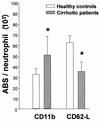Granulocyte colony-stimulating factor improves deficient in vitro neutrophil transendothelial migration in patients with advanced liver disease
- PMID: 11874890
- PMCID: PMC119958
- DOI: 10.1128/cdli.9.2.433-439.2002
Granulocyte colony-stimulating factor improves deficient in vitro neutrophil transendothelial migration in patients with advanced liver disease
Abstract
Bacterial infections are frequent complications in patients with liver cirrhosis. Cirrhotic patients present abnormalities in both innate and adaptive immune responses, including a deficient neutrophil recruitment to infected sites. The purpose of this study was to assess neutrophil-endothelium interactions in cirrhotic patients and evaluate the effects of G-CSF on this process. We studied neutrophil adhesion and transendothelial migration in 14 cirrhotic patients and 14 healthy controls. We also analyzed neutrophil expression of the adhesion molecules CD62L and CD11b in whole blood by flow cytometry. Cirrhotic patients expressed higher levels of CD11b than healthy controls, whereas CD62L expression was significantly lower, suggesting exposure of neutrophils to activating agents within the bloodstream. Neutrophils from cirrhotic patients showed increased adhesion to both resting and tumor necrosis factor alpha-stimulated microvascular endothelial cells and decreased transendothelial migration. Granulocyte colony-stimulating factor (G-CSF) (100 ng/ml) significantly enhanced neutrophil adhesion to microvascular endothelial cells in healthy controls but not in cirrhotic patients. G-CSF also significantly improved neutrophil transmigration in cirrhotic patients and healthy controls. In conclusion, cirrhotic patients exhibit increased neutrophil adhesion to microvascular endothelium and deficient transendothelial migration. G-CSF enhances neutrophil transendothelial migration in cirrhotic patients despite having no effect on neutrophil adhesion. Therefore, G-CSF may be able to increase neutrophil recruitment into infected sites in these patients.
Figures






Similar articles
-
Granulocyte colony-stimulating factor (G-CSF) increases neutrophil migration across vascular endothelium independent of an effect on adhesion: comparison with granulocyte-macrophage colony-stimulating factor (GM-CSF).Br J Haematol. 1996 Jul;94(1):40-7. doi: 10.1046/j.1365-2141.1996.d01-1752.x. Br J Haematol. 1996. PMID: 8757506
-
Granulocyte-macrophage-colony-stimulating factor differentially regulates neutrophil migration across IL-1-activated and nonactivated human endothelium.J Immunol. 1993 Mar 15;150(6):2449-56. J Immunol. 1993. PMID: 7680693
-
The role of granulocyte-macrophage and granulocyte colony-stimulating factors in neutrophil transendothelial migration: comparison with interleukin-8.Exp Hematol. 1994 Mar;22(3):329-34. Exp Hematol. 1994. PMID: 7509293
-
Mechanisms of neutrophil transendothelial migration.Front Biosci (Landmark Ed). 2009 Jan 1;14(5):1596-605. doi: 10.2741/3327. Front Biosci (Landmark Ed). 2009. PMID: 19273149 Free PMC article. Review.
-
Reverse Migration of Neutrophils: Where, When, How, and Why?Trends Immunol. 2016 May;37(5):273-286. doi: 10.1016/j.it.2016.03.006. Epub 2016 Apr 4. Trends Immunol. 2016. PMID: 27055913 Review.
Cited by
-
Spontaneous bacterial peritonitis: a severe complication of liver cirrhosis.World J Gastroenterol. 2009 Nov 28;15(44):5505-10. doi: 10.3748/wjg.15.5505. World J Gastroenterol. 2009. PMID: 19938187 Free PMC article.
-
Paradoxical drop in circulating neutrophil count following granulocyte-colony stimulating factor and stem cell factor administration in rhesus macaques.Exp Hematol. 2007 Jun;35(6):872-8. doi: 10.1016/j.exphem.2007.03.011. Exp Hematol. 2007. PMID: 17533041 Free PMC article.
-
Circulating neutrophil anti-pathogen dysfunction in cirrhosis.JHEP Rep. 2023 Aug 1;5(11):100871. doi: 10.1016/j.jhepr.2023.100871. eCollection 2023 Nov. JHEP Rep. 2023. PMID: 37822786 Free PMC article. Review.
-
Myeloid cells in chronic liver inflammation.Cell Mol Immunol. 2025 Jul 28. doi: 10.1038/s41423-025-01324-4. Online ahead of print. Cell Mol Immunol. 2025. PMID: 40721870 Review.
-
Granulocyte-colony stimulating factor administration ameliorates liver regeneration in animal model of fulminant hepatic failure and encephalopathy.Dig Dis Sci. 2003 Sep;48(9):1797-803. doi: 10.1023/a:1025463532521. Dig Dis Sci. 2003. PMID: 14561004
References
-
- Ades, E. W., F. J. Candal, R. A. Swerlick, V. G. George, S. Summers, D. C. Bosse, and T. J. Lawley. 1992. HMEC-1: establishment of an immortalized human microvascular endothelial cell line. J. Invest. Dermatol. 99:683-690. - PubMed
-
- Andus, T., J. Bauer, and W. Gerok. 1991. Effects of cytokines on the liver. Hepatology 13:364-375. - PubMed
-
- Azzara, A., and G. Carulli. 1997. Morphological features following G-CSF treatment. Haematologica 82:504-505. - PubMed
-
- Barnes, P. F., C. Arevalo, L. S. Chan, S. F. Wong, and T. B. Reynolds. 1988. A prospective evaluation of bacteremic patients with chronic liver disease. Hepatology 8:1099-1103. - PubMed
Publication types
MeSH terms
Substances
LinkOut - more resources
Full Text Sources
Medical
Research Materials

